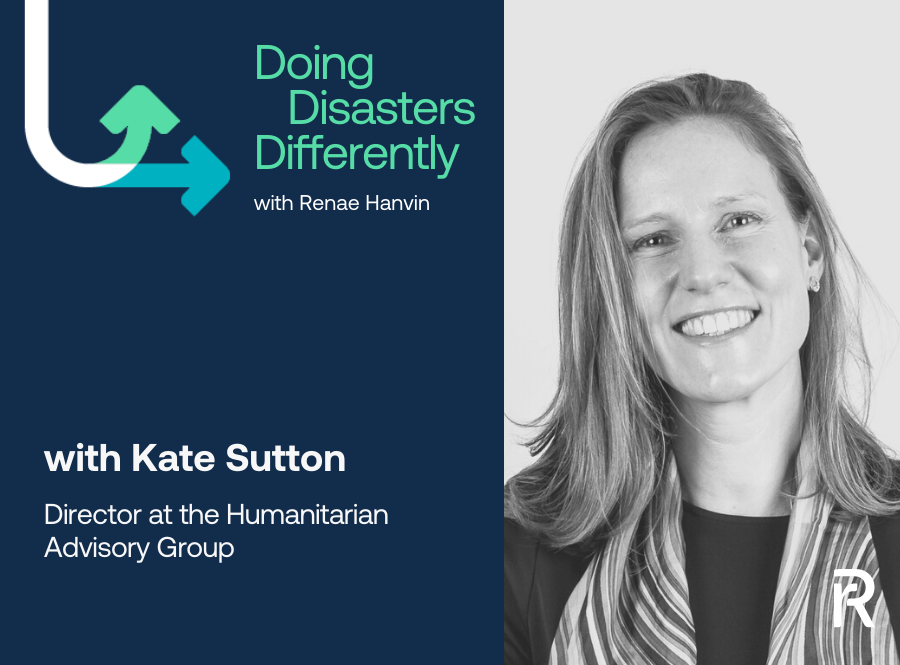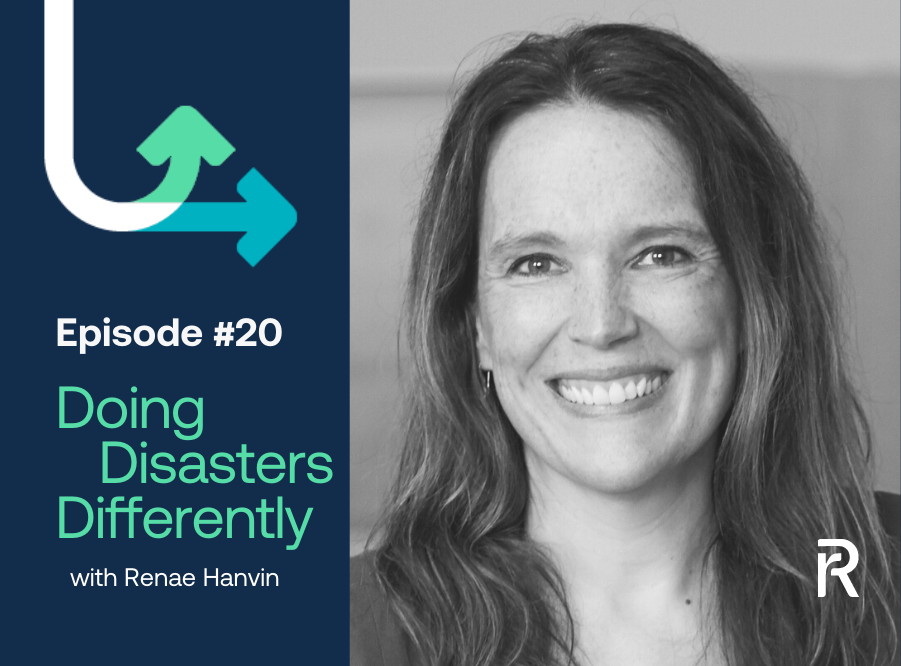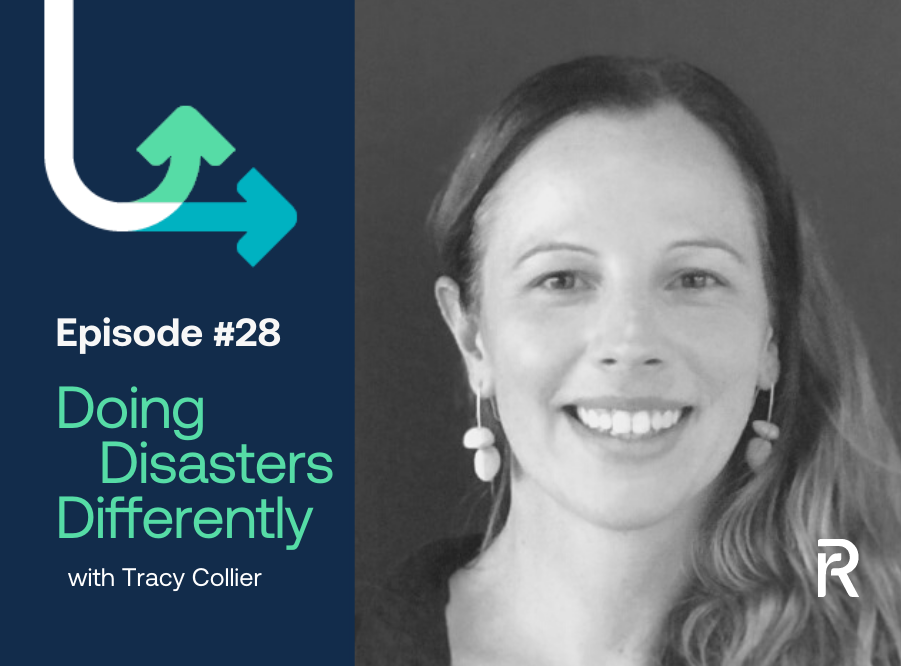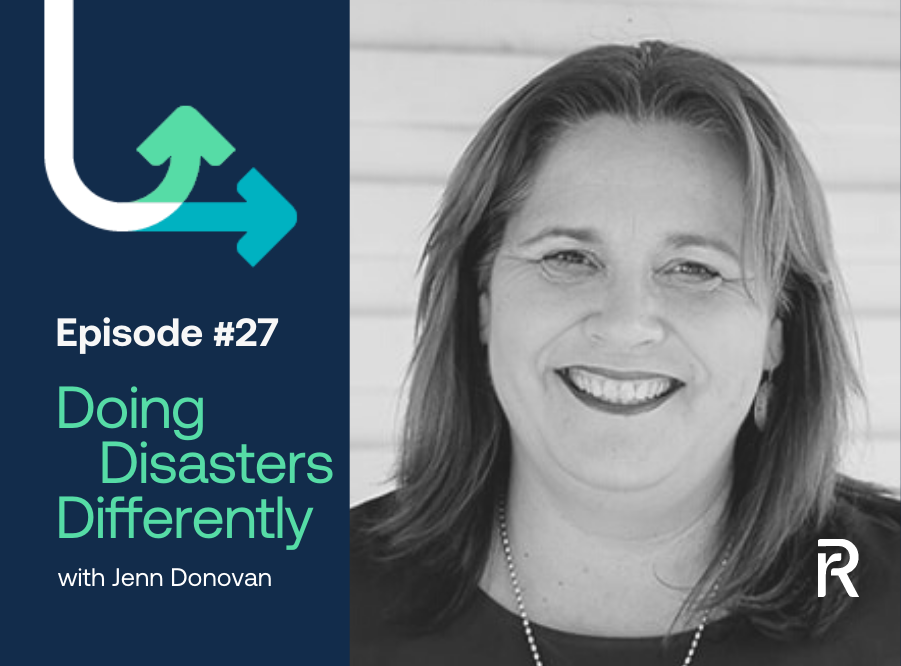
This episode
In this episode, Renae is talking with Kate Sutton, Director at the Humanitarian Advisory Group (HAG) about a humanitarian aid perspective.
Kate is so interesting to listen to offering great insights and expertise on the humanitarian side of disasters. The HAG team are definitely doing disasters differently via an inclusive and collaborative approach.
“I’m a big fan of the work HAG does, like us they are driving change for good in the humanitarian space.”
Make sure you look at their research reports available on their websites, really interesting findings taking a new perspective on the sector.
key moments from the conversation
Kate is a leading contributor to the humanitarian sector in Australia and the region. She has spent over twenty years in operational and leadership roles in international organisations, including eight years field-based in humanitarian contexts.
Kate has a specialist interest in humanitarian protection and displacement, and technical expertise in research, evaluations, training and facilitation. Her in-country experience includes long term positions in Albania, Afghanistan, Ethiopia and Timor Leste and short term assignments to responses in Sri Lanka, Kenya and Indonesia.
Since 2012 Kate has been based in Melbourne as a founding Director of Humanitarian Advisory Group.
Kate has recently undertaken evaluations of Australia’s humanitarian assistance in Syria, Vanuatu and Myanmar. Kate was selected as one of Australia’s top 100 Women of Influence in 2015 and has also recently published work on women in humanitarian leadership – an area of personal interest that has prompted reflection and writing on what makes great women leaders including published writing in the Australian Financial Review.
Kate has a Master of Human Rights Law and a Master of International Development.
Now, I always like to start with where we met. And I’ve been a really big fan of the work HAG do and I know you’re going to explain what HAG means in a little bit. For a number of years I have seen you alongside your business partner Beth at many of the informative events that you’ve run.
And when I was thinking of bringing different voices and perspectives into the podcast series, I was really keen to have HAG part of the discussions because I think the humanitarian perspective is something that we don’t really touch on too much in Australia. But it’s really great to chat with you.
1. So I’m going to start with my first question. We need to have a bit more explanation. I love HAG, but what does it mean? And can you please explain?
Kate Sutton
Why the HAG? It’s a great question to start with, actually, because I think, for many people, they find it quite a strange name to have for a business or an organization. But it actually we were quite passionate about it, in terms of what it actually means originally. So the very original meaning of the word HAG was actually a wise, female orator. And the other meaning was a head rider. So head rider being the person in the village who had one foot in the village and one foot in the world beyond, and then I’m riding the hedge. And so we actually felt that that was a really nice way to capture some of the things that we were trying to achieve with HAG in terms of connecting Australia with things that were happening in other parts of the world, and particularly humanitarian things.
And because obviously, we are a women led business, we wanted to emphasize the strength of women and being able to bring some of these issues to the fore. And, you know, what we now have is actually a whole team of HAGettes, in terms of all our partners and lots of little nuggets in terms of all the little children. So it’s been really nice. And it’s really interesting, because, actually, in some ways, it’s become really great marketing. We didn’t intend it as much at all. We intended it as quite humorous tongue in cheek thing. But, you know, people now actually refer to the HAGs and you know, people remember, remember the word HAG. And so it’s really worked for us in terms of the name of the business.
2. I think it’s very clever. So did HAG come before Humanitarian Advisory Group? Or was that just an organic kind of evolution?
Kate Sutton
So I think we we wanted humanitarian, so we were playing with lots of different words that included humanitarian and when we landed on our Humanitarian Advisory Group, and then realized that it was hard. We just thought that was brilliant and spent a lot of time laughing about it. I think it’s probably quite important as any small business owner to have a bit of a sense of humor and not take ourselves too seriously. That’s probably quite central to how we operate as a business and how we want to be perceived. So it probably came after having the humanitarian component in there.
3.So the Humanitarian Advisory Group brings fresh thinking to challenge the status quo in the humanitarian aid sector. So why and how do you do that?
Kate Sutton
In terms of why I think we felt really strongly that it’s very important to ask if things can be done better or differently. And it is particularly important, I think, for our sector at the moment, because the humanitarian sector, in many ways is, is in a bit of a conundrum, you know, we have increasing humanitarian needs globally. And particularly now with COVID, that’s increased the amount of need exponentially around the world. And what we also have at the same time, is reducing humanitarian funding, so government’s actually reducing their spending on humanitarian aid.
So you have this really tricky situation whereby you’ve got a humanitarian sector that is actually not able to reach all the people that it needs to be able to reach and support. And so I think it’s important, but then there is a role for organizations to step back and ask difficult questions like, well, are we delivering the aid in the best way? And are we reaching the people who really most needed? And what are some of the kind of sticky or more difficult questions that we need to ask? And because we are not operational we do consider ourselves in a really privileged position, there are a number of organizations out there that are doing incredible work in terms of humanitarian assistance in a number of countries.
But they can then be compromised in terms of what they’re able to say, because they don’t want to compromise their operational arm. Because we don’t have that operational arm, we can ask all the difficult questions, we can say things that may be considered, you know, not politically savvy, or maybe more challenging or difficult, but they’re not able to do so we really want to be able to play that role.
4. I think you do that so well. I’ve been a big fan of a lot of reports, and I mentioned before the events that you host. So what are the some of the research findings that you’ve discovered recently and published in some of your reports? And can you give an overview of the humanitarian sector at a minute?
Kate Sutton
So there are a number of research areas that our team gets very passionate about. And maybe what I’ll do is just touch on a couple of those as examples. One of them that we have done a lot of work on is a temporal localization on locally led humanitarian assistance. So typically, if we go 10 years back, a lot of humanitarian assistance would be delivered by international actors. Or at least that’s how it was perceived or how it was portrayed. So you would have large international organizations arriving in countries and being able to provide assistance and a lot of the funding and resource allocation would go through those international actors.
Now, the reality of any humanitarian responses, the people who are first impacted are actually communities themselves, and the people who live in those countries, and the local responders and the local NGOs that operate there. And yet, they don’t get a lot of the funding or the support, and they very often get sidelined in a response. So they may be there in the first week or couple of weeks providing support to communities. And then you may have international NGOs coming in. And in some cases, they actually override or sidelines, those local actors. And so one of the things that we feel very passionately about a Humanitarian Advisory Group is sort of reversing that and having a bit of a shift in the resources and the shift in the power so that local humanitarian actors are actually able to play that leadership role and are supported to do so. And that’s something that, you know, isn’t unique to Humanitarian Advisory Group, there’s been large global movements to try and promote locally led humanitarian action.
One of the pieces of work that we’ve been sort of pioneering and working really hard on is developing frameworks to measure how well that is happening. So how do you actually know whether or not that transfer of power is really happening? And you know, power is such a tricky thing to measure. So when we do I find them kind of interesting research techniques whereby we would do a lot of observation in meetings. And just to give you an example of that, we were in a sort of humanitarian cluster meeting, and we actually looked at who was speaking and for how long so in a three hour meeting, there were 12 participants. 10 of those were national humanitarian actors and two were international. humanitarian actors. When you actually timed how long people were talking during that meeting, we realized that over 60% of the floor time was taken by the international actors. Now, these become really good ways to illustrate whose voice is being heard, and how much power and influence different actors have in the system. And it becomes a really effective way to challenge it as well. You know, why should only two people in a meeting take over 60% of the floor time? You know, what possible justification could there be for that? So it kind of creates those conversations around change, and sort of helping us think about things maybe maybe a bit differently.
Renae Hanvin
I love that. I’m going to take you guys to more meetings with me.
Because it’s so interesting, when you go through the process of disasters, and I guess different stakeholder groups are kind of activated into their either self identified or needs lead roles. And you don’t even think about those little things. So that’s such an, again, a great insight to discover they can have such a big, I guess, focus on some cultural changes or behavior changes that need to be integrated, probably in Australian disaster space, as well as overseas.
Kate Sutton
Yeah, well, that’s exactly right. And I think one of the other areas where this becomes so relevant is when we start looking at things like gender and inclusion, but also a whole bunch of other inclusion issues. And one of our other research streams actually looks at the diversity and inclusion of leadership teams. So trying to understand if you have a more diverse and inclusive leadership team, does that actually lead to better humanitarian response. And this is something that private sector has done absolutely brilliantly. So they know that if they have a board that is gender diverse, or has more racial diversity, or different professional backgrounds, they actually increase their profit by a certain percentage, as a result of that diversity. Now, that kind of understanding and nuance that they’ve been able to attain over the years is something that we haven’t even really started to touch on in the humanitarian space. And I find it very frustrating, because, you know, we send these leadership teams into these contexts to solve very complex problems. And nobody’s actually really done a proper look at the leadership teams themselves.
How diverse inclusive, are they? And what impact is that having on the decisions they make? So one piece of research we’ve just done really recently is trying to understand what impact that has. A lot of this is perception based data, but it’s come out with things like, you know, a diverse and inclusive leadership team in a humanitarian space is six times more likely to make good decisions if they if they are diverse and inclusive, and you know, four times more likely to promote innovation. So I think these are the kind of research findings, which hopefully are really pushing for change, and for people to think about some of these issues.
Renae Hanvin
And as you know, my background is stakeholder engagement, and I’m all about inclusive stakeholders. And, again, most of our focus is obviously in the Australian sector. And it frustrates me and concerns me that and I guess, that’s why we’re creating corporate2community and a few other initiatives and models that we have because it’s the same people sitting around the table, making the same decisions that have the same outcomes.
And you know, disasters are changing, and our nation is changing, and we need to be inclusive, we need multi cultural groups, we need different ages and generations and different genders. I think it’s it’s time now to have the leadership teams and decision making teams and the activation teams reflect society and reflect all those groups that are involved.
Kate Sutton
Yeah, absolutely. I couldn’t agree more. And, you know, there’s a lot of anecdotal data, I think, in in the sector around if you have more women in your leadership team, and they think more about issues like child protection. But what I think is frustrating is that we don’t have more of that evidence base in a more consistent way than just anecdotal data. Because I think you’re absolutely right, we sort of need to have the evidence that shows that when you have that diverse and inclusive team, they do make better decisions for their community, that they are more representative of the community and understanding the issues that are coming up. So I think it’s a big shift our sector needs to take. I also find it fascinating that we’ve become so good and this is, I think, in the domestic space, as well as the international space, we’ve become so good at understanding what diversity and inclusion looks like in the communities we’re working with. So, we will have large handbooks in our sector around how to make sure you’re including people with disabilities in your programming, without any consideration as to whether or not you’re including people with disabilities in your programming teams or your leadership team. So there really needs to be a bit of a shift in the thinking
Renae Hanvin
100% I could not agree more. And in fact, I have talked about the fact for many years and again since 2011 where the national strategy for disaster resilience was created under the context of shared responsibility. It’s like all it seems to have been since then up until recently, is just to basically put a bullet point of a stakeholder and that’s the tick the box to say, well, we’ve included stakeholders because we’ve put them in a document, yet there’s no inclusion of them in the creation of the document. And then there’s certainly no inclusion of them because there’s no activation from that document.
I see a few more research papers coming from your organization. And we might need to talk about that offline. Because I think I have a few other ones I could probably add to your list.
Kate Sutton
Excellent, good.
5. Much like corporate2community HAG seemed to begin over a cup of coffee. James Ritchie, the wonderful James and I had a cup of coffee, and we created this crazy concept about driving greater business participation and contribution before, during and after disasters. Did you ever imagine, I guess the difference and the contribution you would make back then?
Kate Sutton
It’s a really great question. I think it’s an interesting thing, because I don’t think you ever know where something’s going to go to. And I think it was probably the same for you and corporate2community. You come up with this little idea. And you think could it maybe work, and then over the first year, like, wow, we’re still alive, it’s still going. And then we sort of got to this point, I think, and this is mainly a couple of years ago, where, you know, there was this great excitement around surviving as a small business. And we’re set up as a social enterprise, but we are a business. And it’s kind of as a startup, like, so many of them fold early on. And so there was great excitement about the fact that we survived.
But I think the fascinating thing now is that it’s kind of taken on a life of its own, which is an absolute credit to our team. To be honest, we have an amazing team. And they now have kind of taken it further and beyond where I think Beth and I could ever have imagined, you know, their creativity and ideas and their willingness to sort of bring those to HAG and, and really drive different parts of the business. So it has been incredible. I would say it’s become so much more than I could ever have dreamed it would be. And I feel yet just so proud of the team and Beth and yeah, the work that we’ve done. Yeah, it’s been really lovely to watch it grow.
Renae Hanvin
It’s a definite credit to you both. And I think you have such fantastic team members in your wider collective.
6. So can I just move the conversation a little bit to a different angle, so at corporate2community, we’re obviously about private sector, and in many ways, private public sectors. With the countries that you’ve been working with, what have you seen, that’s been great in the sense of a public and private partnership or collaboration?
Kate Sutton
I think it’s such an interesting and growing space, I think the work that you’re doing, and the way you’re promoting this as an approach is, is incredibly important. And where we see it working? Well, I think it can be really transformational in the way that we respond to humanitarian work. So one very concrete example would be the PNG earthquake in 2018. And it was really unique in terms of the humanitarian context, because were the areas that affected were like Highlands PNG, like really, really inaccessible areas, and there’s quite a large mining oil and gas company presence in PNG. And really, the ability of humanitarian actors to respond to that emergency was absolutely facilitated by the presence of the private sector there who were willing and able to really provide resources and support in a way that the humanitarian community couldn’t.
So very concretely, we reach communities faster, much, much faster than would have been able to we, the scale of the response was much greater than it would have otherwise been. And, you know, that a lot of that was around logistic support, but also a lot of it was around the business leadership, being open and willing to do everything they could and to be able to allocate resources to make those things possible. So that was a really kind of concrete example. And it’s been very exciting, I think, over the last 10 years to see this growth in interest for the different sectors to work together.
So you know, organizations like your own and then there are things like the Good Business Foundation, which has just recently been established, which is really looking at how businesses are now wanting to have that sort of sense of purpose around what they’re doing and how they’re giving back and collaborating with different actors and and there’s so many more organizations that are facilitating those linkages, which I just find really exciting.
With my final question always…
1. Okay, so the two areas for me probably linked very closely to our research and some of the conversations we’ve had, I would love to see more recognition of the role that local communities and local actors play in humanitarian response. And I think that recognition of the role they play needs to be not just in terms of saying thank you done a fabulous job, but actually putting resourcing behind it. And, you know, that’s around supporting those national organizations that very often say, Oh, you know, they don’t have enough capacity. And then, you know, you have to ask questions like, well, are we actually providing administration fees like we would do or for any other contracted organizations? Are we actually providing them the, you know, correct financial allocations for them to be able to build their institutional capacity and become really effective humanitarian actors. So I’d love to see their role better recognized and better resourced.
2. The other area that I would really like to see in the humanitarian space, probably both domestically and internationally, is that recognition of the importance of diversity and inclusion, and the ability to not only have different voices at the table, but actually to listen to those voices and to allow them to inform more effective decision making.
Connect with Kate Sutton



